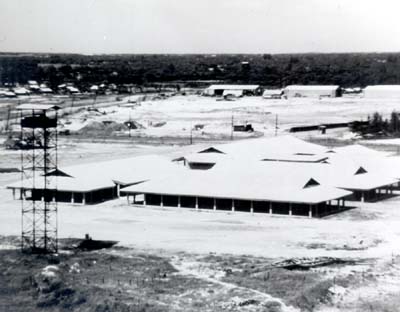
CHILDREN'S HOSPITAL AT QUANG TRI
CHAPTER X
Sustaining Support and Phase-Down
On 8 June 1969, President Richard M. Nixon announced plans for withdrawing 25,000 troops from the Republic of Vietnam. On 1 September the 9th Infantry Division (less its 3d Brigade), twenty Reserve units, two engineer battalions, and one Hawk missile battalion returned to the United States. The systematic withdrawal and reduction of U.S. forces in Vietnam was under way. At the same time the armed forces of the Republic of Vietnam began to accept the full responsibility for the nation's defense. To help the Vietnamese take over and maintain the war effort, the United States created a so-called Vietnamization program in which Army engineers played an important part.
In recent years it has been the policy of the United States to encourage the military of underdeveloped nations to set up programs for using the countries' own resources for socioeconomic development. The concept implies not only developing the ability of governments to provide their people with goods, facilities, and services, but also, and perhaps of greater importance, developing the people's own capacities.
The objectives of the United States in Vietnam at this time were threefold. First was military security, which involved the use of combat units to defeat the Viet Cong and the North Vietnamese and required the destruction of their underground government; second was Vietnamization, improving the competence of the Vietnamese armed forces to provide continuing military security. This mission consisted of giving formal training to South Vietnamese military forces, providing new and modern equipment, and supervising on-the-job training in the use of that equipment. Third was pacification, promoting the socioeconomic development of the country in order to establish a local and national government responsive to the needs of the people and increasing the participation of the people in government. For the first four years of U.S. operations in Vietnam, the major objective was military success. By June of 1969, however, emphasis was being placed on pacification and Vietnamization. Much of the advisory effort of U.S. civilian agencies
[158]

CHILDREN'S HOSPITAL AT QUANG TRI
in Vietnam was directed toward the support and advancement of the pacification effort, called revolutionary development, which was sponsored by the government of Vietnam. Military activities in the area of pacification were directed and integrated by a deputy field force commander for Civil Operations Revolutionary Development Support, established by U.S. Ambassador Elsworth Bunker in May 1967. This mission assumed great importance with the decision to phase down U.S. involvement in Vietnam. The engineers fitted into pacification chiefly through civic action projects that used noncombat skills for the benefit of the civilian population. Included in the civic action program, for example, were the construction and repair of schools, religious buildings, communications facilities, hospitals, and other public buildings. The engineers also provided electric power, medical assistance, vocational training, and education classes. Through such construction and services the engineers made important contributions to national development.
In spite of the priority accorded civic action, most of the engineer troop effort remained committed to the support of units involved in tactical operations and to formal military construction; after June 1967 the engineers added to these the important duties of civic action in behalf of the pacification program, which was intended to free the people from the control of the Viet Cong guerrilla organization.
[159]
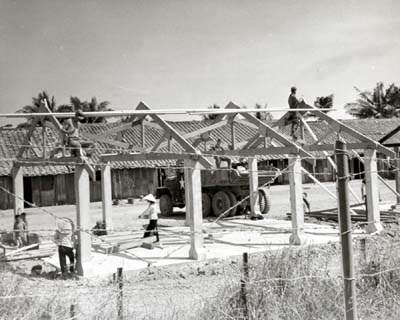
VILLAGERS AND ENGINEERS CONSTRUCT PUBLIC FISH MARKET AT RACH KIEN
Army engineer tactical support fell into one of three categories: operational support, base development, or lines of communication construction. Operational support included combat support and engineer support to logistical operations. Base development included formal, funded construction projects and maintenance of facilities. Lines of communication construction involved the building and maintenance of all surface and air routes of communication. In the calendar year 1968 the distribution of engineer troop effort between these three activities was as follows: combat battalions operational support 44 percent, base development 33 percent, and lines of communication 23 percent; construction battalions devoted 12 percent of their efforts to operational support, 63 percent to base development, and 24 percent to lines of communication. The operational support rendered by combat battalions consisted mainly of land clearing designed to deprive the enemy of concealment along highways and trails over which combat units had to pass. Operational support by construction battalions consisted chiefly of revetment and bunker construction, airfield and bridge repair, and improvements in petroleum product storage, transfer facilities, and base camp defensive structures. Base development was still a large part of the engineer effort, a significant por-
[160]
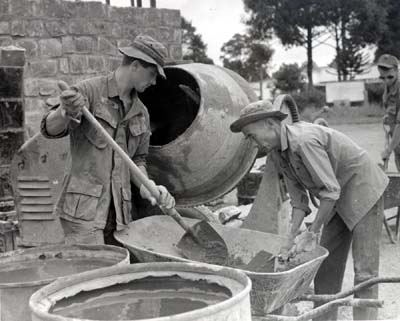
VIETNAMESE BUILD A MASONRY GATE AT BAO LOC for the agriculture school with
the aid of the 116th Engineer Battalion.
tion of which went toward providing physical accommodations for detachments. Effort directed toward lines of communication went chiefly into upgrading and making secure certain military essential roads and bridges throughout Vietnam. This last program had been successful and Viet Cong interdiction of surface traffic had been reduced substantially since 1965.
During 1968 control of national and interprovincial roads was transferred from the Vietnamese Ministry of Public Works to the Vietnamese Defense Ministry, and a more extensive and ambitious line of communication program was initiated by the joint military command in Vietnam. This program included those roads designated essential in support of military operations as well as those contributing to pacification and economic development. By 1969 the new surface lines of communication program was going well, as heavy commercial construction equipment arrived in South Vietnam. This equipment included larger dump trucks, more sophisticated compactors, and front loaders with nearly three times the capacity of the military standard front loader. Although the new
[161]
equipment lacked certain tactically important characteristics such as blackout lights, it had a higher capacity. To provide spare parts not found in the Army system and to help in maintenance of the new equipment, a civilian contractor was hired.
U.S. ARMY, VIETNAM,
LINES OF COMMUNICATION
PROGRAM AS OF 1 MAY 1969
| Status by Calendar Year | Kilometers |
|---|---|
| Completed to Central Combined Committee Standard | 897 |
| To be completed to Central Combined Committee Standard, 1969 | 441 |
| Completed major and minor repairs | 457 |
| To be completed major and minor repairs, 1969 | 64 |
| Construction programmed, 1970 | 943 |
| Construction programmed, 1971 | 907 |
The revised program in May 1969 called for 3,709 kilometers of roads to be completed by the end of 1971. The program was reviewed quarterly and by February 1970 had been adjusted to 3,681 kilometers. The product was to be a two-lane highway built to U.S. highway standards which if constructed in the United States would reach from Washington, D.C., to Las Vegas, Nevada.
The new emphasis on road building dictated a redistribution of engineer troop effort. The proposed phase-down of U.S. troops in Vietnam caused a rearrangement of work priorities. Much of the effort that had been going into base development was rechanneled into the highway program, not only into actual road building but also into the support activities involved. Production plants operated by engineer troops but patterned after stateside industrial layouts produced 340,000 cubic yards of rock and 60,000 tons of asphalt monthly to support the highway program.
Base development programs completed during this period included more Military Assistance Command advisory sites and the improvement of aircraft protection facilities, a particularly high priority item in 1969. Expedient revetments for protecting parked helicopters were demanded beginning in the spring of 1967. Within a few months some form of protection by sandbags or earth-filled walls or drums had been provided for each of the more than four thousand Army helicopters in South Vietnam. The protection sometimes consisted of revetments arranged in an L-shape, sometimes parallel walls between adjacent helicopters and, in other instances, walled enclosures in the configuration of a square with one side missing. Many helicopters soon had revetments in two or more locations. The hurried effort marked an attempt to reduce damage from enemy long-range attacks by mortars and rockets. The long helicopter blades and the height over which protection was desired
[162]
EMPLOYMENT OF ENGINEER TROOPS, 18TH BRIGADE
|
|
February 1969
|
March 1969 |
October 1969 |
January 1970 |
|---|---|---|---|---|
|
Operational Support |
48 |
50 |
54 |
47 |
|
Base Development |
25 |
18 |
8.5 |
6 |
|
Lines of Communication |
20 |
32 |
37.5 |
47 |
EMPLOYMENT OF ENGINEER TROOPS, 20TH BRIGADE
|
February 1969 |
March 1969 |
January 1970 |
|
|---|---|---|---|
|
Operational Support |
55 |
46 |
not available a |
|
Base Development |
24 |
23 |
not available a |
|
Lines of Communication |
19 |
31 |
62 |
a Breakdown is not available. The total for the two items is 38 percent. (Chart 6) The effort devoted to operational support included land clearing, which had become increasingly more important to the engineer command. Clearing was done not only in support of combat units but also to open up the countryside and give the Vietnamese farmer more arable land.
created serious problems for engineers, not the least of which was drainage. The standard revetment stood four feet high, but some reached twelve feet above the parking surface. Design was made more difficult by the aviator's insistence that the revetments allow the helicopter to fly out of them unimpeded. Size and height of maintenance hangars also posed difficulties. The first prefabricated hangar was built in 1966 and others were constructed in 1967 and 1968. By 5 May 1969 the 27th Engineer Battalion had constructed an 11,520-square-foot UH-1 maintenance hangar at Phu Bai; the 815th Battalion was constructing a 33,450-square-foot hangar at Pleiku; and the 554th Battalion was constructing an 11,520-squarefoot hangar at Cu Chi.
For the Army engineers 1969 was a year of transition in their support functions. The second half of the year saw the curtailment of many base construction projects and a consistently high emphasis on road construction projects. The lines of communication program for 1970 was even more ambitious than that for the year before. The effort expended by U.S. Army engineers on highway construction was markedly effective in improving military capability in Vietnam. It was also to be an important legacy to the people of Vietnam. The opening and upgrading of major highways and feeder roads provided the people in rural areas access to the cities and permitted transportation and commerce between cities. For example, in 1966 the little hamlet of Plei Xo clung tenaciously to its corner of the
[163]
CHART 6-DISTRIBUTION
OF ENGINEER EFFORT, 1965-1970 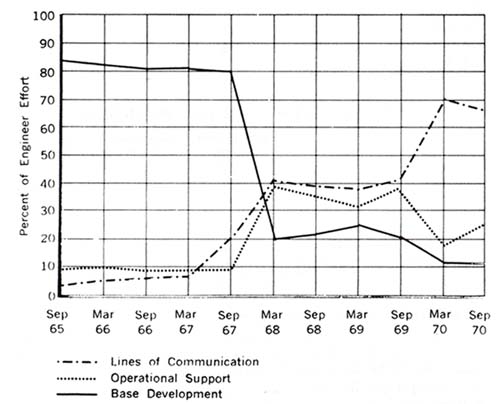
Central Highlands like a ghost town that refused to die. Although this primitive settlement was only eighteen miles from the bustling city of Pleiku, there was no roadway and the farmers and charcoal makers of Plei Xo brought their merchandise to town on foot. Then the U.S. Army engineers began to cut Highway 19 west from Pleiku to Duc Co. By 1969 Plei Xo had a superhighway and a window to the outside world. Sturdy, thatched homes and bright shops and churches now line both sides of the highway at Plei Xo. Farmers trade their produce with the people of Pleiku for some of the comforts of modern life.
Thousands of communities like Plei Xo have been connected by the most ambitious road-building program in the nation's history and one of the largest single engineering projects ever undertaken by the U.S. military in a foreign country. (Map 11) When the project is completed, modern high-speed roads will tie together the major population centers of the country. These new asphalt lines of communication have changed traffic patterns immensely. Instead of an occasional oxcart, steady streams of traffic now fill the
[164]
[165]

HIGHWAY THROUGH HAI VAN PASS IN 1970
roads. This change alone has brought an economic uplift to Vietnam, and the peasant can see for the first time what the government and the military can do for him.
Brigadier General Harold R. Parfitt commented upon his return from Vietnam in November 1969 on the civic action program:
. . . The special circumstances in this war have permitted the engineers to do a lot more work than ever before in nation building. Construction of major road networks, opening of secondary roads; a multiplicity of revolutionary development; all have contributed to improving the nation in such a way that the average citizen could see and appreciate what was being done by US troops to improve his lot. To many people reared in poverty and misery, this was as meaningful or more so than our efforts to prevent communist domination of their country.
Civic action was closely allied with the highway program. Roads, besides being essential to immediate tactical operations, were a
[166]
necessity for the sustained economic development of the Republic of Vietnam.
There were other efforts by U.S. Army engineers that will have a more lasting effect than any road network. Engineers cleared land and canals and provided earth fills for schools and piers. They designed projects for water supply systems, electrical power systems, agricultural and logistical improvements, and irrigation. Although the engineers could devote their efforts to civic action projects only when their duties to tactical troops were fulfilled, their achievements in this field along with the civic action aspect of the highway program led Lieutenant General William R. Peers to comment: "The psychological impact upon the local population was tremendous. The outstanding support and cooperation given by the US engineers in this regard was most commendable."
Typical of the effort expended by the engineers was the rehabilitation of a small Vietnamese Army training camp near Qui Nhon. When young engineer Captain Eric A. Kevitz arrived at this training camp as an adviser, conditions were wretched. The mudthatched buildings which served as barracks for the Vietnamese trainees were little more than crumbling ruins; the straw roofs leaked, and the winds blew sheets of rain through the windows and the broken walls. The captain decided that he would make every effort to rehabilitate the camp. His appeal to engineer units in Qui Nhon yielded the required construction material from surplus or salvage. He then persuaded elements of the 623d Engineer Construction Company of the Vietnamese Army to guide the trainees in construction of the new camp. Work began and the captain was everywhere-planning, manipulating, directing, organizing, and supervising. Within two months eight new barracks had been built and plans had been approved for twelve more, plus a kitchen, a dispensary, and two mess halls. A water pump was secured, and a generator and electrical distribution system began providing light for the camp. Twelve months after the captain had arrived, thirty barracks had been built. There was a 25-bed dispensary, two 300man kitchens, four 200-man mess halls, a motor pool, an officers' quarters, and a theater. The dreary training camp had become thoroughly livable through the initiative and aggressiveness of one young engineer.
In 1965 the Republic of Vietnam armed forces had very few engineers. In prior years some individuals who showed promise had been educated in higher schools of formal engineering, for
[167]
the most part in universities in Hanoi or France. These graduates, highly proficient in technical engineering, were concentrated in national centers of engineering administration such as the office of the chief of engineers of the armed forces of Vietnam, but their number was small. Most South Vietnamese engineers were poorly trained and unfamiliar with modern engineer equipment; facilities to provide them with the training they needed were lacking. Units were poorly equipped and funds for procuring new equipment were inadequate. From this corps of unskilled and ill-equipped engineers, the United States sought to develop a well-trained, competent, and greatly expanded engineer force in South Vietnam.
The low skill level of Vietnamese Army engineer troops went deeper than a lack of training in engineering methods. Most Vietnamese simply lacked the education and experience to understand the rather sophisticated techniques used in modern military construction. The roots of the problem went back to the French educational system used in Vietnam. Only the best students reached high school and only the superior and the richest were educated beyond that level. As a result, most of the men in the armed forces had almost no formal education. It was therefore necessary for the United States to provide instruction in such basic subjects as reading and writing before undertaking any program of formal training in the engineering sciences. Communication between the instructor, if he was an American, and the Vietnamese pupil was also a problem. A basic knowledge of English was a necessity in grasping the more technical terms and concepts. There was also a psychological barrier to overcome, both in formal training and on-the-job training. Some American instructors felt that the Vietnamese were of inferior intelligence and unable to learn, a misconception that came about partly because of the language barrier, partly because the student lacked specialized training and was unfamiliar with U.S. engineer equipment and methods. These instructors might appear to be condescending; the Vietnamese naturally resented the implied superiority. Fortunately, such cases were the exception rather than the rule. Generally, the relations between representatives of the respective national engineer organizations were warm, pleasant, and mutually beneficial. On both sides there was no lack of willingness to cooperate.
Despite problems, by 1969 the Army Engineer School at Phu Cuong was training 3,000 Vietnamese officers and enlisted men a year in many specialized skills. However, the school was still unable to meet the need for engineers. To supplement the supply of welltrained troops, the Vietnamese chief of engineers ordered the development of an on-the-job training program at the unit level.
[168]
Selected instructors were assigned to units throughout the country to promote the proper training of engineer troops.
A few Vietnamese engineer officers and noncommissioned officers were sent to the U.S. Army Engineer School at Fort Belvoir, Virginia, to attend engineering courses. This program will contribute to an unproved level of engineering competence throughout the Vietnamese Army in future years.
The formal engineer training of Vietnamese soldiers was an ambitious and productive operation. A more important contribution to the training of engineer troops, however, was made through the joint participation of Americans and Vietnamese engineers in an extensive on-the-job training program.
Major General Joseph M. Heiser, Jr., commanding general of the 1st Logistical Command, proposed the so-called Buddy System in 1968 to help train the South Vietnamese soldier in logistical activities such as supply and maintenance. The program aimed at placing Vietnamese military units under U.S. unit sponsorship so that both the unit and the individual could benefit from observing and participating in operations by the corresponding type of U.S. Unit It was logical to apply the concept to engineer units engaged in formal construction projects. Help in combat support operations by engineer units also continued to be provided by the previously functioning unit advisers-U.S. officers and noncommissioned officers assigned to Vietnamese battalions and larger formations. Feeling that firsthand observation and experience on the job would be the best way to improve the skills of the Vietnamese Army, he predicted that the same success that had come out of the Korean Augmentation to the U.S. Army program in Korea would be derived from the Buddy System in Vietnam. General Creighton W. Abrams personally approved the Buddy concept in January 1969, and assigned to U.S. Army unit commanders the responsibility for military training assistance to the Vietnamese Army. Progress was slow at first, but the impetus provided when General Theodore J. Conway, the head of logistical activities on the staff at Military Assistance Command, Vietnam, established Instruct and Advise Teams to assist Vietnamese units was more than enough to get the project off the ground. The Buddy System gained momentum and became a tremendously effective program for modernizing the Vietnamese Army and increasing its combat and support capabilities. The concept was adopted with enthusiasm by the Army Engi-
[169]
neer, Major General William T. Bradley, and his subordinate units were soon deeply committed to the program.
Quite often in 1969 and 1970, South Vietnamese engineer battalions were assigned a joint project with U.S. Army engineer battalions. Operation SWITCHBLADE which began 15 December 1969 was one such operation. It involved three Vietnamese land clearing companies, the 218th, the 318th, and the 118th, and the U.S. Army's 62d Battalion, which was responsible for training the three Vietnamese companies. Vietnamese trainees were assigned to the several U.S. Army land clearing companies of the battalion and deployed with their counterparts to War Zone C for forty-five days of land clearing operations in support of various U.S. combat units. Equipment from U.S. land clearing companies recently inactivated was used to equip the Vietnamese units. Upon completion of the training, one Vietnamese land clearing company was assigned to each of the Vietnamese I, II, and III Corps.
Working beside an American engineer soldier on a certain piece of equipment, the Vietnamese engineer soldier demonstrated that he could quickly learn to operate a new machine. Vietnamese
[170]
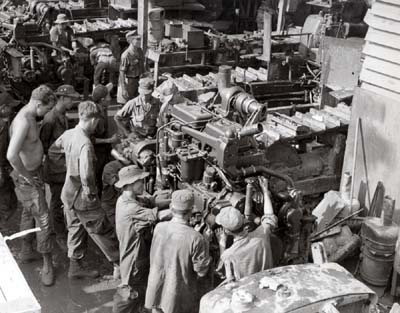
STUDYING D7E TRACTOR USED IN ROME PLOW OPERATIONS
accompanied Americans on many projects and learned all phases of engineer operations. The American engineer soon developed a great respect for the Vietnamese engineer and showed a sincere desire to convey to his "buddy" as much of his own knowledge as possible. Through maximum contact and training under the Buddy System, the Vietnamese engineer developed a noteworthy level of competence. On-the-job training reached all levels of the South Vietnamese Army and the lowest private developed skills that five years earlier he would not have even understood. The success of the engineer program of Vietnamization can be attributed to the adaptability of the Vietnamese soldier and the determination of the American engineer to convey his own knowledge and skill.
Equipment Transfer and the Logistic Legacy
As the U.S. withdrew its forces from the Republic of Vietnam, it left behind a logistic complex of bases, airfields, petroleum product and ammunition storage areas, cantonment areas, warehouses, maintenance shops, utility systems, and lines of communication.
[171]
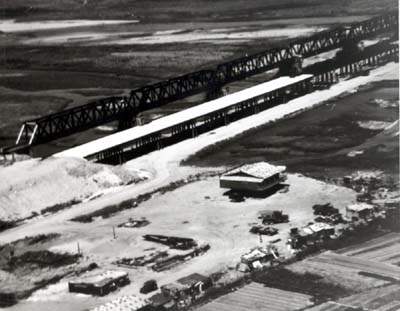
BRIDGE BUILT BY VIETNAMESE ENGINEERS NEAR TUY HOA
Some prefabricated buildings were dissembled and transferred from the sites of their original erection in Vietnam to complexes garrisoned by U.S. troops; other structures were dismantled and returned to the United States. For the most part, however, the products of millions of dollars worth of construction by the U.S. Army engineers remain in Vietnam for the use of the Vietnamese.
As withdrawal from Southeast Asia began, a typical unit marked for transfer or inactivation continued to perform its mission as long as possible, then turned over responsibilities and bases to the Republic of Vietnam armed forces. The transfer of equipment was one of the most important turnovers. In June 1969 U.S. Engineer units began shifting equipment to Vietnamese engineer units on a massive scale. On 31 May General Abrams had set strictly defined criteria for the transfer of equipment under the Improvement and Modernization Program for the Vietnamese Armed Forces. These criteria insured that all used U.S. Army equipment was safe to operate, serviceable, and operable to the extent required for its intended purpose. Replacements for any missing or defective parts had to be on order for delivery to the Vietnamese armed forces be-
[172]
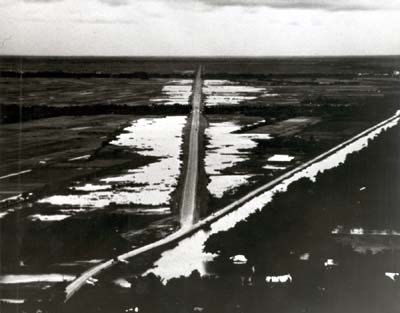
AERIAL VIEW OF HIGHWAY 4 AND FEEDER ROAD IN THE DELTA
fore a particular piece of equipment was considered transferable. During September 1969, units of the 18th Engineer Brigade transferred approximately 193 separate major items of equipment to the 40th Vietnamese Base Depot, the only engineer base depot of the Vietnamese Army. In the same month the 20th Engineer Brigade was involved in similar equipment transfers. The brigade was ordered to provide 200 major items; a single battalion was designated to coordinate all activities. Units of the brigade were to deliver end items in acceptable condition to a central collecting point at Long Binh. Once a substantial number of items was on hand and determined ready for transfer, a date was set for mutual inspection and receipt with Vietnamese Army representatives as well as Military Assistance Command advisers. This equipment was subsequently assigned to engineer units in the field. Some additional items went directly to the Vietnamese units. Similar arrangements proceeded meanwhile in the 18th Engineer Brigade. When the 63d Vietnamese Engineer Battalion was activated in December 1969 at Nha Trang, the U.S. Army's 35th Group provided it with equipment. The 864th Battalion assisted the new unit by instructing its men on operational and maintenance procedures required by their
[173]
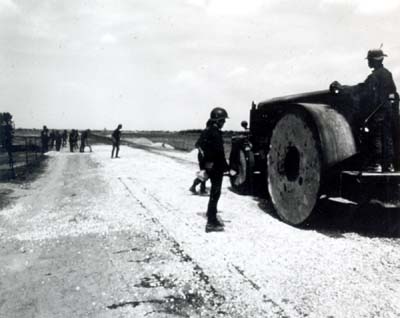
VIETNAMESE ENGINEERS WORKING ON HIGHWAY 9 NEAR DUC HOA
new equipment. Some new equipment arriving in Vietnam was transferred directly to Vietnamese engineer units.
Vietnamese engineer construction units played a more active role in the highway construction program during 1970. A total of 165 kilometers of road was made the responsibility of the Vietnamese Army units along with 50 bridges totaling 2,879 meters in length. As Vietnamese engineers gained experience, additional segments of the highway program were assigned to them, but the lines of communication construction received a lower priority than the American engineers had afforded it. Concerned about morale, the South Vietnamese expended considerable effort on a program aimed at providing austere housing for military dependents, many of whom had no homes and existed in a state little better than that of camp followers.
Nevertheless, considerable progress continued to be made in the highway program. By February 1970, 467 kilometers of roadway had been completed in the I Corps Tactical Zone. In II Corps Tactical Zone half of the 1,400 kilometers scheduled for completion by the end of 1970 had been finished. In the Saigon region, 451
[174]
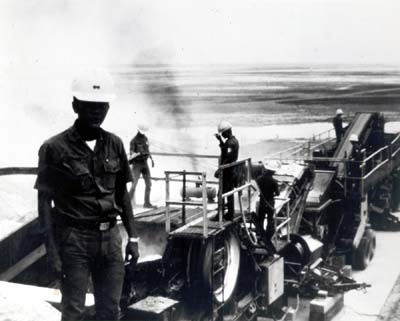
VIETNAMESE OPERATING ROCKCRUSHER AT NUI SAM QUARRY
kilometers of a planned 1,068 had been completed. An additional 379 kilometers were scheduled for completion in III Corps Tactical Zone by the end of the year. The Mekong Delta, hampered by unstable soil and a severe shortage of road building material, continued to lag behind the rest of the country in receiving major road improvements. Ambitious plans for the highway system, however, included support operations reaching beyond 1970 to overcome this gap in the country's total road construction.
The Vietnamization of the engineer support mission proceeded admirably during 1969 and 1970. Formal and on-the-job training programs enlarged the construction capabilities of the growing Vietnamese corps of engineers. The transfer of logistical bases and badly needed machinery to the Army of the Republic of Vietnam enabled its engineers to apply their new skills. Senior Vietnamese engineer officers, becoming confident of their ability, were informally suggesting that they could handle a greater share of the lines of communication program. The load was being passed to the Vietnamese and there appeared to be every prospect that they would handle it successfully.
[175]
For years North Vietnamese regulars and Viet Cong had enjoyed the immunity of retreat into sanctuaries established in Cambodia. To aid the Vietnamization process by depriving the enemy of these sanctuaries or by seriously impeding his use of them, U.S. and South Vietnamese forces attacked the strongholds during May and June 1970. U.S. Army engineers led the way. The area of operations in the south was generally in the portions of Cambodia known as the Parrot's Beak, the Dog's Head, and the Fishhook, and in the vicinity of Snoul, Memut, and Krek. In the highlands region the area of operation was along the axis of Highway 9, west of Pleiku.
Engineer support for the operation was assigned by the Commanding General, 20th Engineer Brigade, to the 79th Engineer Group. Engineer resources, in addition to the division battalions and the organic engineer company in the 11th Armored Cavalry Regiment, included the 31st and 588th Engineer Battalions (Combat) and the 554th, 92d, and 62d Engineer Battalions (Construction), as well as several separate companies and detachments. Priority was at first given to routes of advance and forward tactical airfields, and later to construction of forward logistical bases at the airfields and all-weather logistical support routes. The 62d Engineer Battalion was committed primarily to provide entry into suspected enemy supply and cache areas, a tribute to the tactical effectiveness of Rome Plow operations.
Accomplishments under tactical pressure were impressive. Engineer support elements built fifty-six kilometers of new road, plus twenty-three separate fixed bridges. In addition, twenty fire support bases were constructed for infantry, armor, and artillery units.
Of particular moment was the tactical delivery of bridging by CH-47's and Flying Cranes. From Quan Loi, where preassembled ramp and trestle sections had been stocked, helicopters lifted and placed at one bridge site both the center trestle and the two connecting spans to each abutment. The bridge was completed eight hours after the first engineer troops had arrived by helicopter. In another instance, Flying Cranes delivered a 38-foot bridge in two trips. These successful deliveries would have been almost impossible by ordinary means. At the time, all suitable surface transportation was deeply committed to other critical tasks.
The support operation was an outstanding success. Once again the engineer soldier, career professional and draftee alike, demonstrated the willingness and the ability to meet the challenge and overcome formidable obstacles to accomplish a mission. Seven 20th Brigade engineers were killed and 132 wounded in this campaign.
[176]
Major General John A. B. Dillard, the U.S. Army, Vietnam, Engineer and senior Army engineer in Vietnam, was killed when his helicopter was shot down while he was reconnoitering Highway 509 about ten miles southwest of Pleiku. Colonel Carroll E. Adams, Jr., Commanding Officer, 937th Engineer Group; Lieutenant Colonel Fred V. Cole, Commanding Officer, 20th Engineer Battalion; Captain William D. Booth, Aide-de-Camp; Command Sergeant Major Griffith A. Jones of U.S. Army Engineer Command, Vietnam; and five others also perished in the crash. Command Sergeant Major Robert W. Elkey was the sole survivor.
[177]
Go To:
Return to the Table of Contents